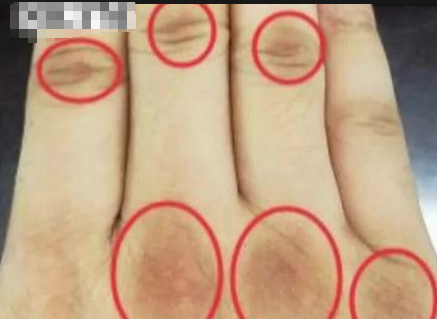
Our hands tell stories. They are maps of a life lived—showing the nicks from old projects, the sunspots from decades of driving, and the gentle wrinkles that come with time. We learn to recognize these normal signs of wear and tear. But sometimes, a new mark appears that doesn’t quite fit the narrative. One of the most telling, yet least discussed, is the appearance of dark, velvety patches on the knuckles.
These patches aren’t like age spots. They often have a thicker, almost suede-like texture and a darker, sometimes brown or grayish hue. They might appear on the knuckles of your fingers, your toes, your elbows, or even in the creases of your armpits or neck. It’s easy to mistake them for a simple rash or a stubborn dirt stain. But in the world of medicine, this specific sign has a name: Acanthosis Nigricans.
And its appearance is a direct, visual telegram from your endocrine system. Dark patches appearing on your knuckles suggest your insulin levels are chronically and dangerously high.
Let’s break down exactly what’s happening inside your body to cause this external change.
The Insulin Spillover Effect
Under normal circumstances, when you eat, your body breaks down carbohydrates into glucose (sugar), which enters your bloodstream. In response, your pancreas releases insulin. Think of insulin as a key that unlocks your cells, allowing glucose to enter and be used for energy.
However, when we consistently consume more sugar and refined carbohydrates than our bodies can handle, the system gets overwhelmed. The cells, constantly bombarded by insulin, stop responding properly. They become “resistant” to the key.
Your pancreas, seeing that blood sugar is still high, panics and pumps out even more insulin. This creates a state of hyperinsulinemia—chronically high levels of insulin in the blood.
How High Insulin Darkens Your Skin
This is where your knuckles come in. All that excess insulin in your bloodstream doesn’t just float around harmlessly. It has a powerful side effect: it stimulates the rapid growth of skin cells (keratinocytes). It also triggers skin cells to produce an excess of melanin, the pigment that gives skin its color.
The areas of the body with friction—like knuckles, elbows, and skin folds—are particularly sensitive to this growth signal. The result is a patch of skin that becomes thick, dark, and velvety. The dark patch on your knuckle is essentially a visible record of your body’s struggle to manage its blood sugar.
Why This is a Critical Warning Sign You Must Not Ignore
Acanthosis Nigricans is not a skin disease; it is a symptom of a severe metabolic problem. It is one of the clearest early warning signs of insulin resistance, which is the driving force behind Prediabetes and Type 2 Diabetes.
Seeing these patches is like seeing the “Check Engine” light on your car’s dashboard. You can still drive, but you know a significant underlying issue needs immediate attention. Ignoring it can lead to complete engine failure. In this case, “engine failure” means a progression to full-blown diabetes, with all its associated risks for your heart, kidneys, eyes, and nerves.
What to Do When You See the Patches
- Don’t Scrub or Bleach Them: The darkness is not dirt; it’s an internal signal. No amount of scrubbing will remove it. The only way to reverse it is to address the root cause.
- Schedule a Doctor’s Appointment Immediately: This is non-negotiable. See your primary care physician and point out the patches. Use the term “Acanthosis Nigricans.” This will immediately alert them to the underlying metabolic concern.
- Demand the Right Tests: Your doctor should order a Hemoglobin A1c test, which gives a three-month average of your blood sugar levels. They may also check your fasting insulin and glucose levels to get a full picture of your insulin resistance.
- Take Back Control with Lifestyle Medicine: The beautiful part of this story is that insulin resistance is highly reversible. You have the power to make the patches fade by:
- Reducing Sugar and Refined Carbs: This is the most critical step. Cut out sugary drinks, white bread, pasta, and pastries.
- Incorporating Movement: Regular exercise, even brisk walking, makes your cells more sensitive to insulin again.
- Eating Whole Foods: Focus on vegetables, lean proteins, and healthy fats.
Those dark patches on your knuckles are a gift of awareness. They are your body’s way of creating a billboard for a problem that is otherwise silent. By heeding this visual warning, you can catch a devastating disease in its earliest, most reversible stages. You can lower your insulin, watch the patches fade, and, in doing so, secure a healthier, more vibrant future.